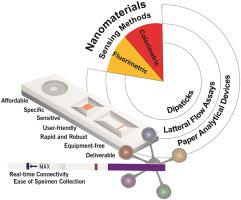Analytica Chimica Acta ( IF 6.2 ) Pub Date : 2022-11-22 , DOI: 10.1016/j.aca.2022.340640 Forough Ghasemi 1 , Nafiseh Fahimi-Kashani 2 , Arafeh Bigdeli 3 , Azad H Alshatteri 4 , Samira Abbasi-Moayed 5 , Sabah H Al-Jaf 6 , Mariam Y Merry 7 , Khalid M Omer 7 , M Reza Hormozi-Nezhad 8

|
Paper-based analytical devices (PADs) have shown great promise for point-of-care testing and on-site detection of analytes with chemical, biochemical, and environmental importance owing to their low cost, convenience, scalability, portability, and biocompatibility. The World Health Organization stated that sensors should meet the ASSURED criteria (affordable, sensitive, specific, user-friendly, rapid and robust, equipment-free, and deliverable). Paper-based optical sensors meet most of these criteria, making them in high demand and applicable in remote areas. Optical PADs outputs are obtained by different means, such as dyes, nanostructures, redox agents, and pH indicators. The outstanding physical and chemical characteristics of nanostructures, their intense signals, and tunable optical properties make them ideal for many sensing platforms, including paper-based ones. This review focuses primarily on paper-based nanosensors using various nanostructures to fabricate and produce optical signals for visualization. We describe the fundamentals and state of the art of PADs and comprehensively explain the following topics: paper types as the substrate of PADs, PAD fabrication approaches, nanostructure stabilization on PADs, signal acquisition, data handling, interpretation of results, sensing mechanisms, and application areas. We also discuss future trends and strategies to enable PADs to reach their full potential and increase their commercialization opportunities.
中文翻译:

纸基光学纳米传感器——综述
基于纸质的分析设备 (PAD) 由于其低成本、便利性、可扩展性、便携性和生物相容性,在具有化学、生化和环境重要性的分析物的即时检测和现场检测方面显示出巨大的前景。世界卫生组织表示,传感器应满足 ASSURED 标准(负担得起、灵敏、特异性、用户友好、快速且稳健、无设备和可交付)。纸质光学传感器满足其中大部分标准,因此需求量很大,适用于偏远地区。光学 PAD 输出通过不同的方式获得,例如染料、纳米结构、氧化还原剂和 pH 指示剂。纳米结构的突出物理和化学特性、它们的强信号和可调光学特性使其成为许多传感平台的理想选择,包括纸质的。本综述主要关注使用各种纳米结构来制造和产生用于可视化的光学信号的纸基纳米传感器。我们描述了 PAD 的基本原理和最新技术,并全面解释了以下主题:作为 PAD 基材的纸张类型、PAD 制造方法、PAD 上的纳米结构稳定性、信号采集、数据处理、结果解释、传感机制和应用领域。我们还讨论了未来的趋势和战略,以使 PAD 充分发挥其潜力并增加其商业化机会。我们描述了 PAD 的基本原理和最新技术,并全面解释了以下主题:作为 PAD 基材的纸张类型、PAD 制造方法、PAD 上的纳米结构稳定性、信号采集、数据处理、结果解释、传感机制和应用领域。我们还讨论了未来的趋势和战略,以使 PAD 充分发挥其潜力并增加其商业化机会。我们描述了 PAD 的基本原理和最新技术,并全面解释了以下主题:作为 PAD 基材的纸张类型、PAD 制造方法、PAD 上的纳米结构稳定性、信号采集、数据处理、结果解释、传感机制和应用领域。我们还讨论了未来的趋势和战略,以使 PAD 充分发挥其潜力并增加其商业化机会。



























 京公网安备 11010802027423号
京公网安备 11010802027423号